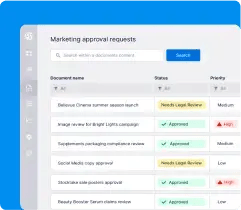How to secure budget for legal tech
The case for Legal tech is overwhelming. That much we all agree on.
Plexus Team
September 15, 2019

- The Transformation Doom Loop
- The 10 Tips for Success
- 1. Don’t over-complicate the buying process
- 2. Your budget isn’t just for spending on Law Firms
- 3. Only go to the CEO or CFO as a last resort
- 4. Get creative when optimising your internal budget
- 5. Don’t ever socialise your technology project
- 6. Use Empathy maps
- 7. Define roles in the decision-making cycle… and make their authority clear
- 8. Focus on the business impact, not the Legal need
- 9. Align your business case to a strategic business case
- 10. Sell your idea with numbers
or

The Legal transformation doom loop
Learn the common blockers that stand in the way between your legal team and transformation success.
We work with over 130 General Counsels worldwide which gives us a unique ability to see the key issues they have with implementing a transformation agenda.
Although 98% of General Counsel rate transformation as critical to their success, ultimately a vast majority aren’t implementing anything yet. In fact, only ¼ are and most of that are at the beginning of their transformation journey.
Interestingly when we look at the root causes of some of the issues General Counsel were trying to face, we found that they didn’t have a sophisticated system of record or technology tool to enable their function to do more with less.
As a result, these Legal functions are often years behind the expectations set by more mature functions. Most General Counsel know that they should be investing more in technology, but they aren’t quite clear on what they should be doing and – more challengingly – how to get it done.
The transformation doom loop
When we look at how General Counsel are trying to get things done, we see common mistakes. We call it the Transformation Doom Loop. There are a lot of factors in the loop, but these are the most pertinent:
1. The tomorrow fallacy
In other words, you are too busy. It’s ironic, we know. The reason to invest in technology is to get more done with less. Yet, often the Legal function is too busy to invest in the technology strategy. There’s always one more thing to do – getting the board papers off the desk or reviewing that contract – which pushes your project to tomorrow. And often, tomorrow never comes.
2. Under resourcing
Most team members are already working too many hours, which means you fail to ring-fence the resources required to get the project off the ground. And trying to secure resources from elsewhere is one of the biggest challenges for a Legal tech project.
3. The legal-centred business case
Most team members are already working too many hours, which means you fail to ring-fence the resources required to get the project off the ground. And trying to secure resources from elsewhere is one of the biggest challenges for a Legal tech project.
4. Under-focus on adoption
Even if you do get the initiative started, you fail to mandate the adoption, which means the rollout doesn’t happen as it should.
Download the guide
Learn the common blockers that stand in the way between your legal team and transformation success.

The 10 tips for success
By following these 10 tips, you will better articulate the value of your initiative to the business and improve its chances of success.
1. Don’t over-complicate the buying process
It doesn’t need to be. The reality is that you are buying things every day, and this doesn’t need to be any different. Anything you buy requires three very simple things: a well-defined problem, a credible solution, and a way to fund it.
2. Your budget isn’t just for spending on law firms
Historically, the legal budget was specifically designed to be spent on external law firms. This has created a mindset that’s difficult to shake. What you need to remember is this: Just because your budget is titled ‘Law Firm spend’ doesn’t mean it’s just for Law Firms. Think about it. What’s the purpose of the budget? To get Legal work done.
3. Only go to the CEO or CFO as a last resort
It’s practically in their job description to stop the business from spending on new initiatives, and they are highly incentivised to keep this party line. This means you should only go to them if you’ve exhausted all options within your own budget.
4. Get creative when optimising your internal budget
Partner with other functions to optimise your budget. Securing the resources and budget for a large tech initiative is always easier if more than one department can benefit – especially if that department has a larger budget.
5. Don’t ever socialise your technology project
The probability of getting live reduces exponentially with number of stakeholders involved. If you involve more than two people in the decision, it’s likely that it will never happen.
6. Use empathy maps
Understand the role that every stakeholder should have in the decision, then manage those expectations. The empathy mapping process will help you understand how to speak the language of different functions and decisions-makers to secure buy-in.
7. Define roles in the decision-making cycle… and make their authority clear
One of the biggest stumbling blocks you can face is when people get confused about their roles, and IT or another function ends up making the decision. Ultimately, the GC needs to own the decision.
8. Focus on the business impact, not the legal need
If you need to sell your idea to get additional resources, centre the business case on the business impact or outcome, not the Legal need. The simple truth is CFOs don’t care about Lawyers. What they do care about is the business’s bottom line.
9. Align your business case to a strategic business case
You can demonstrate how your Legal technology solution will shorten the sales cycle and make the sales team more productive by significantly reducing contract times.
10. Sell your idea with numbers
Numbers will help you successfully articulate the value of your project to decision makers. Use hard commercial realities as the headlines for your business case.
Plexus Team
We’re the Plexus Team - part tech nerds, part legal innovators, passionate about helping in-house legal teams work smarter.
All your legal work in one AI-powered platform.
Faster reviews, self-service for business teams, and smarter compliance in every workflow.
Related resources
Don't miss out on Perspectives by Plexus each month
Legal news, innovation and insights delivered straight to your inbox.








.png)



